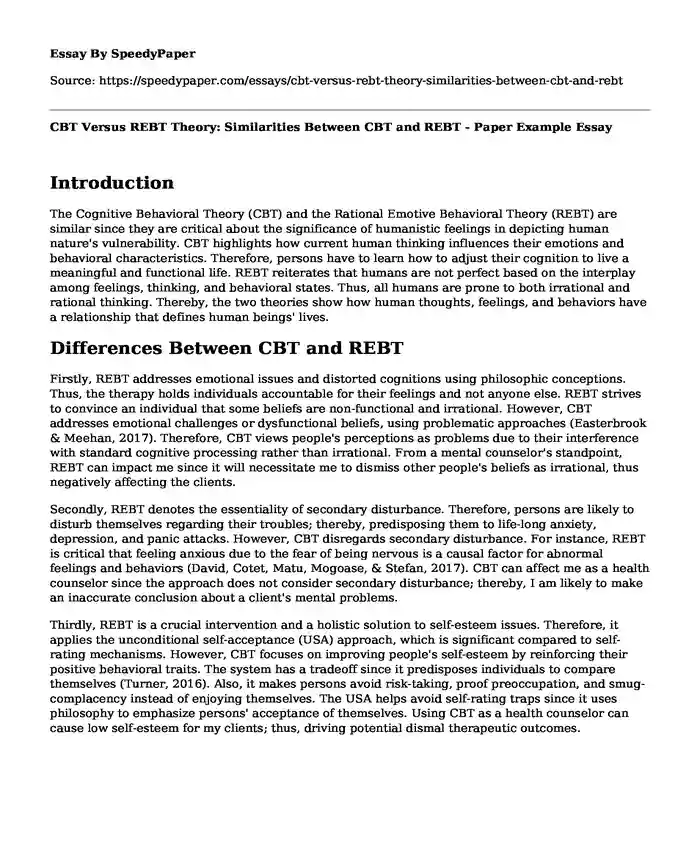
| Type of paper: | Essay |
| Categories: | Behavior |
| Pages: | 3 |
| Wordcount: | 675 words |
Introduction
The Cognitive Behavioral Theory (CBT) and the Rational Emotive Behavioral Theory (REBT) are similar since they are critical about the significance of humanistic feelings in depicting human nature's vulnerability. CBT highlights how current human thinking influences their emotions and behavioral characteristics. Therefore, persons have to learn how to adjust their cognition to live a meaningful and functional life. REBT reiterates that humans are not perfect based on the interplay among feelings, thinking, and behavioral states. Thus, all humans are prone to both irrational and rational thinking. Thereby, the two theories show how human thoughts, feelings, and behaviors have a relationship that defines human beings' lives.
Differences Between CBT and REBT
Firstly, REBT addresses emotional issues and distorted cognitions using philosophic conceptions. Thus, the therapy holds individuals accountable for their feelings and not anyone else. REBT strives to convince an individual that some beliefs are non-functional and irrational. However, CBT addresses emotional challenges or dysfunctional beliefs, using problematic approaches (Easterbrook & Meehan, 2017). Therefore, CBT views people's perceptions as problems due to their interference with standard cognitive processing rather than irrational. From a mental counselor's standpoint, REBT can impact me since it will necessitate me to dismiss other people's beliefs as irrational, thus negatively affecting the clients.
Secondly, REBT denotes the essentiality of secondary disturbance. Therefore, persons are likely to disturb themselves regarding their troubles; thereby, predisposing them to life-long anxiety, depression, and panic attacks. However, CBT disregards secondary disturbance. For instance, REBT is critical that feeling anxious due to the fear of being nervous is a causal factor for abnormal feelings and behaviors (David, Cotet, Matu, Mogoase, & Stefan, 2017). CBT can affect me as a health counselor since the approach does not consider secondary disturbance; thereby, I am likely to make an inaccurate conclusion about a client's mental problems.
Thirdly, REBT is a crucial intervention and a holistic solution to self-esteem issues. Therefore, it applies the unconditional self-acceptance (USA) approach, which is significant compared to self-rating mechanisms. However, CBT focuses on improving people's self-esteem by reinforcing their positive behavioral traits. The system has a tradeoff since it predisposes individuals to compare themselves (Turner, 2016). Also, it makes persons avoid risk-taking, proof preoccupation, and smug-complacency instead of enjoying themselves. The USA helps avoid self-rating traps since it uses philosophy to emphasize persons' acceptance of themselves. Using CBT as a health counselor can cause low self-esteem for my clients; thus, driving potential dismal therapeutic outcomes.
CBT Version
I will use guided discovery with my clients since it helps a client familiarize with my viewpoint. Therefore, it will allow me to ask the clients questions that challenge their perceptions and widen their thinking. Guided discovery entails allowing clients to reflect on they synthesize information. As a result, multiple alternative thinking processes are uncovered. The alternative review forms the blueprint that a therapist can use to change their clients' perceptions and behaviors (Kazantzis, Beck, Clark, Dobson, Hofmann, Leahy, & Wong, 2018). Also, it necessitates the provision of evidence to underlying certain presumptive beliefs and non-evidence assumptions. In the process, clients are likely to learn how to perceive things using other people's perspectives. Notably, the education process is based on what the client has not experienced before. Thus, I can establish collaborative efforts with the clients on the right path to ensure optimal therapeutic results.
References
David, D., Cotet, C., Matu, S., Mogoase, C., & Stefan, S. (2017). 50 years of rational-emotive and cognitive-behavioral therapy: A systematic review and meta-analysis. Journal of Clinical Psychology, 74(3), 304–318. https://doi.org/10.1002/jclp.22514
Easterbrook, C. J., & Meehan, T. (2017). The therapeutic relationship and cognitive behavioral therapy: a case study of an adolescent girl with depression. The European Journal of Counselling Psychology, 6(2), 1–24. https://doi.org/10.5964/ejcop.v5i2.85
Kazantzis, N., Beck, J. S., Clark, D. A., Dobson, K. S., Hofmann, S. G., Leahy, R. L., & Wing Wong, C. (2018). Socratic dialogue and guided discovery in cognitive behavioral therapy: a modified Delphi panel. International Journal of Cognitive Therapy, 11(2), 140–157. https://doi.org/10.1007/s41811-018-0012-2
Turner, M. J. (2016). Rational Emotive Behavior Therapy (REBT), irrational and rational beliefs, and the mental health of athletes. Frontiers in Psychology, 07(1). https://doi.org/10.3389/fpsyg.2016.01423
Cite this page
CBT Versus REBT Theory: Similarities Between CBT and REBT - Paper Example. (2023, Dec 13). Retrieved from https://speedypaper.net/essays/cbt-versus-rebt-theory-similarities-between-cbt-and-rebt
Request Removal
If you are the original author of this essay and no longer wish to have it published on the SpeedyPaper website, please click below to request its removal:
- Essay Sample: The Economic Approach to Human Behavior
- Paper Example: Innovation and Adaptability Portfolio
- Paper Example. Biological Domain
- Paper Example. Kelecton Case
- Paper Example: The Patient's Behavior Change
- Free Essay - Staffing the Organisation
- The Free Paper on 7- Habits of Highly Effective People
Popular categories




